BEAUTY AND FLAVOR
The Good, the Bad, and the Ugly (in my opinion)
For better or worse, every year nurseries and seed companies send me a few plants or seeds to try out and perhaps write about. The “for better” part is that I get to grow a lot of worthwhile plants. The “for worse part” is that I have to grow some garden “dogs.” (I use the word “dogs” disparagingly, with apologies to Sammy and Daisy, my good and true canines.) Before my memory fades, let me jot down impressions of a quartet of low, mounded annuals that I trialed this year.
Calibrachoa Superbells Blackberry Punch was billed as heat and drought tolerant, which it was. As billed, it also was smothered in flowers all summer long. It’s a petunia relative and look-alike. Still, I give it thumbs down. But that’s just me; I don’t particularly like purple flowers, and especially those that are purple with dark purple centers.
I’ll have to give Verbena Superbena Royale Chambray a similar thumbs down. 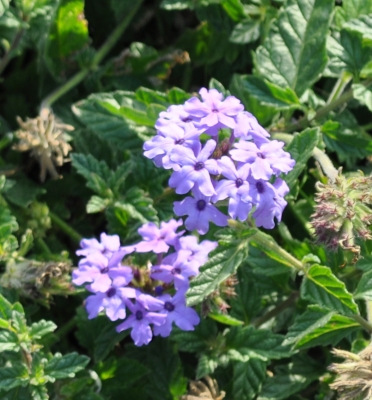 It’s that purple again, light purple in this case. Also, the plants weren’t exactly smothered with flowers and most prominent, then, were the leaves which were not particularly attractive.
It’s that purple again, light purple in this case. Also, the plants weren’t exactly smothered with flowers and most prominent, then, were the leaves which were not particularly attractive.
Golddust (Mecardonia hybrid) made tight mounds of small yellow flowers nestled among small yellow leaves. I give this one a partial thumbs up. The flowers were too small and there weren’t enough of them even if the leaves alone did make pleasant, lime green mounds.
And finally, a rousing thumbs up for Goldilocks Rocks (Bidens ferulifolia). This plant also was a low mound of tiny leaves, needle-shaped this time. Sprinkled generously on top of the leaves all summer long were sunny yellow blooms, each about an inch across and resembling single marigolds. Flowering was nonstop, even up through the many recent frosts here, right down to 24° F.
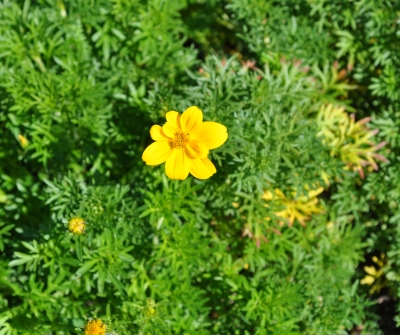
Bidens in its botanical name caused me slight pause when I planted Goldilocks, not because of any displeasure with our president, but because the common name for this genus is sticktight, or beggartick. You know those half-inch, flat, 2-pronged burrs that attach to animals — and, inconveniently, your socks — when you walk through wild meadows? 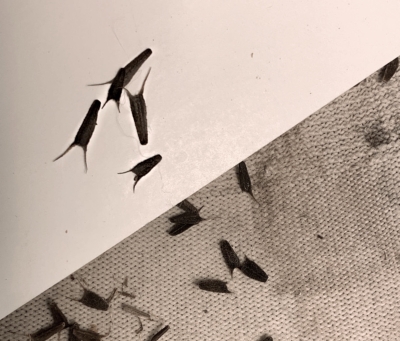 Those are Bidens, trying to spread. (Not to be confused with the round, marble-size burs of burdock.)
Those are Bidens, trying to spread. (Not to be confused with the round, marble-size burs of burdock.)
No problem with Goldilocks Rocks that lined my vegetable garden paths. The flowers were too low to reach any higher than my shoes.
Ugly, Beautiful, and Tasty
Despite the recent spate of cold temperatures, there’s still fruit out in the garden, hanging on and ready for picking at my leisure.
The first is medlar (Mespilus germanica), a fruit that was popular in the Middle Ages, but not now. Its unpopularity now is due mostly to its appearance. One writer described it as “a crabby-looking, brownish-green, truncated, little spheroid of unsympathetic appearance.” The fruits resemble small, russeted apples, tinged dull yellow or red, with their calyx ends (across from the stems) flared open. I happen to find that look attractive. 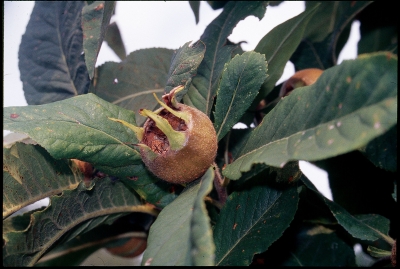
The harvested fruit needs to sit on a counter a few days, like pears, before it’s ready to eat. Worse, from a commercial standpoint these days, when ready to eat the firm, white flesh turns to brown mush. Yechhh! Except that it’s delicious, with a refreshing briskness and winy overtones, like old-fashioned applesauce laced with cinnamon.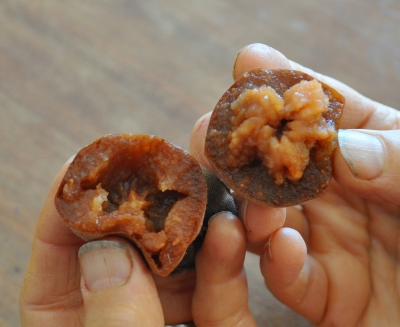
The plant itself is quite beautiful, a small rustic-looking tree with elbowed limbs. In late spring individual white blossoms resembling wild roses festoon the branches. In autumn, medlar leaves turn warm, rich shades of yellow, orange, and russet. 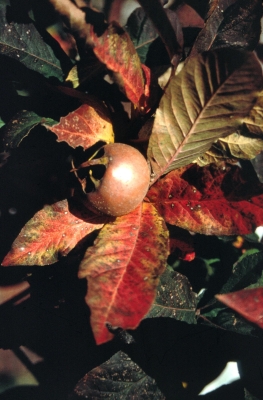
I would bill medlar as very easy to grow, except here on the farmden. A few years ago, a pest started attacking my fruits, turning the flesh dry, rust-colored, and inedible. I have yet to identify this pest (rust?) which is absent just about everywhere else. Do any other of you few medlar growers have anything to say about this pest, if you’ve seen it?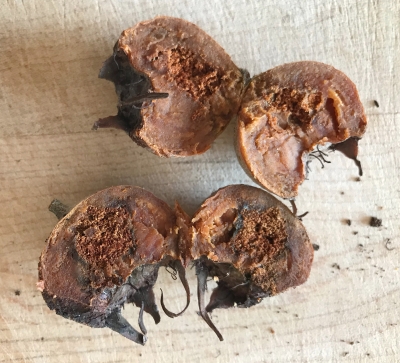
Beautiful and Tasty
Walking around my home to the bed supported by a low, stone wall along my front walkway, we come to lingonberry (Vaccinium vitis-idaea). This fruit never fails to stir a smile, a dreamy look, perhaps even a tear in the eye of Scandinavians away from their native land. Nonetheless, it’s actually is native throughout the colder zones of the northern hemisphere.
Lingonberry is an evergreen groundcover growing only a few inches high; I grow it both for its beauty and its fruit. In spring the cutest little white, urn-shaped blossoms dangle upside down (upside down for an urn, that is) singly or in clusters near the ends of thin, semi-woody stems. 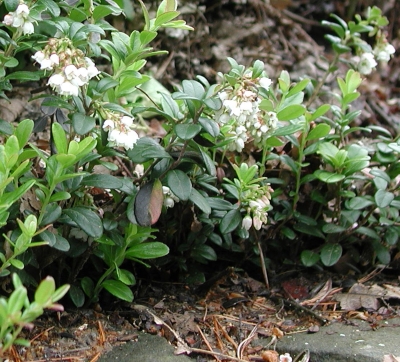 The bright red berries hang on the plants for a long time, well into winter, with their backdrop of holly-green, glossy leaves making a perfect holiday decoration in situ.
The bright red berries hang on the plants for a long time, well into winter, with their backdrop of holly-green, glossy leaves making a perfect holiday decoration in situ.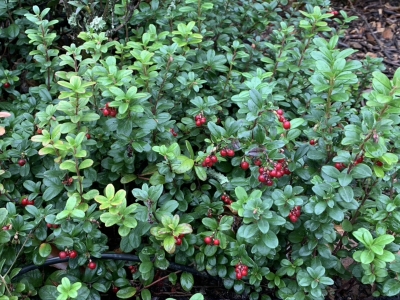
The key to success with lingonberries is suitable soil. Like blueberries, a close relative, they enjoy, they demand, a soil rich in organic matter, well aerated, consistently moist, and very acidic. I created these conditions with some peat moss in each planting hole, a year ‘round mulch of wood chips, leaves or sawdust, topped up annually, and sulfur applied to bring soil pH to between 4 and 5.5.
Lingonberries have been put to lots of culinary uses besides the usual lingonberry jam. I like to eat them straight from the plants. They’re not sweet, but they are delicious.
(I considered the two above-mentioned fruits so worthwhile that each warranted a chapter in my book Uncommon Fruits for Every Garden. This book’s out of print now, but is due to be revised and re-issued again in a couple of years. Some of the information in that book can be found in my currently available books Grow Fruit Naturally and Landscaping with Fruit.)

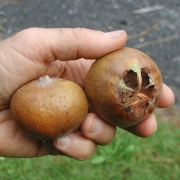

Speaking of petunias: would you happen to have any recommendations for perennials, or bulbs, instead, that might do well in window boxes?
I’d also like to know how to keep soil in standard — that is to say, relatively shallow, and self-draining — window boxes from becoming too easily nutrient-depleted.
Thanks!!
As far as flower recommendations, that’s too broad a question, depending, among other things, on what you like and where you are.
As far as maintaining soil fertility, a soluble fertilizer can do this. Even better is to take a least some of the soil out each year and replace it with fresh soil. You can even do this without inordinately disturbing plants growing in the box. By the way, the soil should be “potting soil,” not straight garden soil.
I was on a website & there was a thread titled:
Meet the Bidens. I thought it was political, so I did not read it, then I got bored & read it, it was about a group of wild herbs used in meds. I worked with plants for over 40 years & did not know the name Bidens, I have seen the plant, just not the name Bidens .
Beginning last year, I’ve had the same problem with my medlars (East Hartford, CT). I too would like to know the cause and possible remedy.
Do you have recommendations for fruits a community garden could successfully grow for a food pantry?
I do, but it depends on where the garden is. Where is it, and in what climate zone?
I’ve been losing cranberries and lingonberries alike. Leaves go brown in one spot and within a couple weeks the whole plant is brown. Roots similarly brownish orange and I suspected root rot, but not sure since they like moisture. Blueberries in the same patch didn’t seem to be affected… At least not yet. Any ideas?
All these plants like moisture but, at the same time, require a well drained soil. I suspect drainage is the problem. Your choices, if that is the case, is to replant in a well-drained soil, plant on mounds at existing site, or, if possible, carry excess water away via ditches or “tile” to a lower site. Plenty of organic matter and mulch keep a well-drained soil pleasantly moist, not sodden.
I am interested in hanging plants that will withstand our changing climate
Thank you Susan
Succulents.
Nice! I have a few lingonberries growing alongside some wintergreen in the understory of my blueberries. I don’t have medlars, but right now I’m still harvesting dozens of Asian Persimmons. Been eating them in the crisp phase.
Do Lingonberries get eaten by chipmunk, squirrels, mice, birds, or deer? I guess what I really want to ask is, do you need to do anything to prevent them from eating your berries? Thank you
Speaking from personal experience, of the animals mentioned, only birds never ate my lingonberries, except for my ducks and chickens who no longer can get to them. Few or no animals get to the lingonberries now because I have two very alert, outdoor dogs, Sammy and Daisy, who like to hang out in or near the beds, which are right up against my home. Fortunately, Sammy and Daisy do not like lingonberries, in contrast to their love of persimmons, pears, apples, and gooseberries.